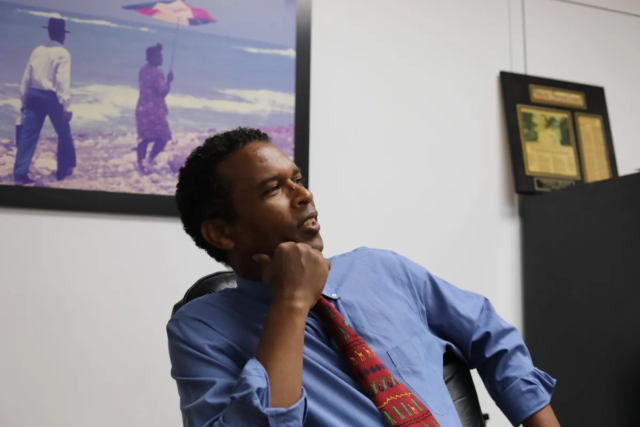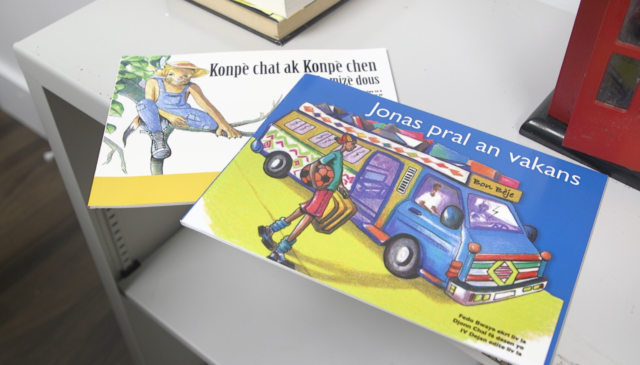The Haitian Times
www.haitiantimes.com
By Ashley Miznazi

MIAMI — Faidherbe “Fedo” Boyer vividly recalls the moment he saw Creole in a new light.
He was at South Shore High School in Brooklyn’s Canarsie neighborhood in the 1970s, celebrating Haitian culture alongside other students who had recently arrived in the United States, administrators, teachers and the school board. Up until the point he moved to the United States, Boyer’s schooling had been all in French. So when poet Dimitri Hilton, a special guest, read a poem written in Creole, the words captivated Boyer.
‘My God, I don’t have to make an effort to understand this. This is easy. This is us,’ he remembers thinking.
Decades later, Boyer, 60, is making that connection possible for Haitians worldwide through his work as a translator. Earlier this year, Boyer reached a career highlight when he translated into Creole The New York Times special report about Haiti. The Ransom, a highly acclaimed five-part series, explains how the debt Haiti was forced to pay its French enslavers crippled the nation.
To Boyer, the most rewarding aspect is that groups in Haiti have been reading the Creole version to farmers, whose role as a cash cow for Haiti is covered in the piece, and other compatriots.
“For them to be able to read that information, and understand it because it’s in their own language, is amazing,” Boyer said.
Catherine Porter, a reporter on The Times’ series, said translating the project into Creole and making it accessible to Haitians in the diaspora “seemed self-evident.” She searched among book publishers, linguists and reporters for Creole translators with the expertise and time to work on the 30,000-word series and found that Boyer’s name came up repeatedly.
Working with him, she said, proved “a bit emotional” for him too because of the history of stigmatization of this language in Haiti.
“He was working around the clock, he has a strong work ethic,” Porter said. “It was really important to both of us.”
Finding translation, by way of education
Boyer’s dedication to his craft began after seeing a need for Creole and trying to fill it, like many entrepreneurs tend to do. After graduating college with a degree in education, Boyer had left New York to work in the Florida school system. It was during his 12-year tenure as an educator, six of them in elementary schools, that Boyer noticed the bilingual language programs available in Spanish. He saw then the opportunity to extend such activities to Creole-speaking kids.
“It’s like this is it, this is what I’m supposed to do, this is what I will continue to do because there’s room to grow.”FEDO BOYER
Boyer then left education, intending to create his own English-Creole bilingual software. To build that well, however, Boyer sought to sharpen his translation skills. So he moved to Haiti.
There, he studied with Yves Déjean, a leading scholar of Haitian Creole who taught classes exclusively in Creole at the State University of Haiti. Boyer and Déjean worked on a Creole dictionary that taught Boyer much of what he knows about the language.
When he returned to Florida, Boyer brought together a team to provide translation services. CreoleTrans was born.
“It was a relief, it was liberating to be able to do it,” Boyer said. “It was scary in the beginning, [when] you start and you have to build up a clientele.”
“From that point on, I didn’t see myself doing anything else, but that,” he added. “It’s like this is it, this is what I’m supposed to do, this is what I will continue to do because there’s room to grow.”
CreoleTrans has operated out of Miami since 1999 and recently moved to an office in North Miami. The team, currently of 10 translators, completes written translations as well as recorded and live interpretations in Creole, French, Spanish and Portuguese.
Though the translation software he first envisioned has not materialized, Boyer has translated an elementary reading series for Miami-Dade County and written several children’s books in Creole. His series Konpè chat ak Konpè chen series features folk characters in cautionary tales.

“There’s so much to Creole than people seem to think there is, so much to study about the language,” Boyer said. “And it’s such a great tool, it’s very underutilized.”
Advancing the ‘language of resistance’
Enslaved Africans in Haiti developed spoken Creole as a contact language sometime between 1680 and 1730, using it as a form of resistance. By the time Haiti became independent in 1804, everyone spoke Creole, but French was adopted as the official language for nearly two centuries and used in formal settings, such as the schools Boyer attended.
In the 1970s, the official orthography was standardized, though spelling and grammar vary. Creole became an additional official language when the Constitution of 1987 recognized Creole as the only language that binds the Haitian people together.
Nowadays, Creole is used more and more on television shows and radio and in primary schools, where children are taught to write it.
Creole became an additional official language when the Constitution of 1987 recognized Creole as the only language that binds the Haitian people together.
Such progress is due to people like Boyer, some colleagues say.
“His work is one of the most important I can use for my students because there are a lot of documents and publications in Haitian Creole, but not all of them respect the official setting of the language, the writing system, the grammar rules,” said longtime collaborator Nicolas André, the Haitian Creole program director at Florida International University.
“Fedo is quite different because he really knows the language and there is no mixture like some people would do with Haitian Creole and French,” André said. “His work is the kind of work we are trying to do.”
Still, Boyer says, there’s room for progress in gaining further acceptance of the language. He is disappointed to still see Haitian birth certificates or legal proceedings in French, knowing the majority of Haitians do not speak or write French.
“We’re still fighting the belief by a lot of educational institutions and educators in Haiti that only French can be the vehicle for education in Haiti, or French is the vehicle for education in Haiti because it interconnects Haiti with the rest of the world,” Boyer said. “That is so untrue.”
Filling a community need
Boyer, the second oldest of five children, lives near Little Haiti with his wife Edwidge Danticat, the Haitian American novelist, and their two daughters. His ties and proximity, in addition to his work, keeps Boyer attuned to the Haitian community’s needs beyond language access.
“It’s a front-row seat to a lot of interesting stories and happenings in the community,” Boyer said. “Sometimes we feel privileged to be there, to transfer from one language to the other, but also to be involved in the stories.”
To help at times, CreoleTrans has provided pro-bono translation services to people, non-profit organizations and educational institutions. In the process, he’s learned much about the community’s challenges. Everything from immigration documentation and aiding evicted tenants to explaining how the U.S. criminal justice works compared to Haiti’s.
“He is very inspiring, he is very knowledgeable about social issues and is a cheerful person,” said Audy Alvarez, a CreoleTrans colleague. “Even when financially things aren’t going the way we expected, he is always motivated. Working with him, we catch that same motivation.”









